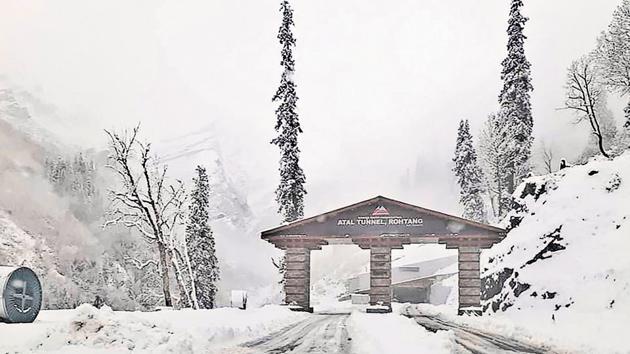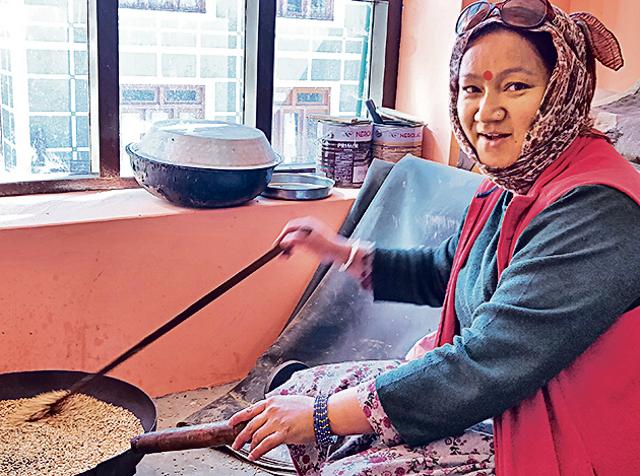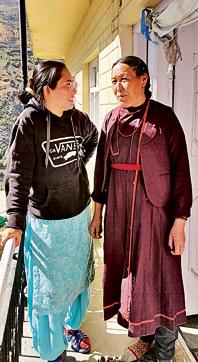Wonderland: Hope mingles with doubt in Lahaul as Atal Tunnel faces its first winter
There’s excitement over the expected boom in tourism, concern over the drifts of litter already piling up, and worry over robberies and Covid-19. Above all, villagers are waiting to see how the engineering marvel will fare in the heaviest snows.
Dr Ranjeet Vaid has spent the last few days distributing medicines in the Lahaul Valley in Himachal Pradesh. Entire villages here have tested positive for Covid-19, and the reason for this seems to be the recently inaugurated Atal Tunnel.

“The Valley has suddenly become more accessible,” says Dr Vaid, district surveillance officer at Lahaul. Sissu, Khoksar, Khandsar and Gondla, the villages closest to the tunnel, have been the worst-affected and have had to be declared Covid-19 containment zones.
These villages have also been the worst affected by the piles of trash that the growing number of visitors are leaving behind, the traffic they cause, and the robberies associated with the coming and going of strangers in tiny hamlets that could until now leave their front doors unlocked. Amid it all, it still isn’t clear if the routes to and through the tunnel will withstand the heavy snows. And even if they do, access may have to be restricted or closed to keep the pandemic at bay.
Still, the gigantic Rs 3,200-crore, 9.2-km engineering marvel has definite benefits. It cuts through the Pir Panjal mountains, which means Dr Vaid can now send distressed patients to Mandi for treatment, and residents like Dechen Pawnspa, 30, a teacher in Chandigarh, can plan winter visits to family.
Pawnspa says the tunnel has brought excitement and new fears. Her family home is in Yurnath village off the main highway, 44 km from the tunnel, but even here there have been robberies. Truckfuls of the famous Lahaul potatoes, newly harvested and lying by the highway, have been stolen. “Suddenly we feel we should lock our doors,” she says.

On the plus side, she can now plan visits home for the Halda new year, usually celebrated in January or February. It’s been years since she got to spend this time with family, eating traditional buckwheat marchu rotis and a meat stew that has simmered all night over a tandoor.
The Lahaul Valley is hemmed in by some of the world’s highest mountain passes — a road through the 13,060-ft-high Rohtang Pass leads to Kullu Manali, another through the 16,043-ft Baralacha and 16,730-ft Shinkula passes leads to Leh. Both roads fill up with snow in the winter months, leaving the Valley marooned. The tunnel seeks to change that.
Much of the impetus for the project has come from the Army, which must send supplies further north to the volatile India-China Line of Actual Control. In that sense the Atal Tunnel is seen as a trailblazer, a test case for tunnels planned on the passes further north.
For the people of Lahaul, there is excitement over the predicted boom in the food, hospitality and tourism sectors, but below it all lies an uneasy undercurrent. There are fears of being overrun and ecologically ruined.
Things have quietened down now, as a snowfront moves in and the Covid cases make news, but in the first six weeks after the opening of the tunnel, hordes of visitors drove in from Punjab, Haryana, Delhi and across Himachal Pradesh. “It’s like a dream that we can drive to Lahaul, have tea in Sissu and be back in Manali in a few hours,” says Meru Ghoshal, who has been to Lahaul twice already since the tunnel opened on October 3.

At Keylong’s Hotel Dekyid, Sherab Barongpa’s phone rings all the time. His 24-room hotel that served mainly as an overnight stop for bikers on the road to Ladakh, has seen demand skyrocket, the 35-year-old says.
Sunil Chellingpa, 38, who runs luxury campsites near the icy blue Chandratal Lake, is expecting his business to double “at least”. It is a good time to invest and expand, he says. He wants to open a restaurant on a plot of land close to the highway. “I will serve pizza,” he says.
In Sissu, the first village at the north face of the tunnel, there are four new hotels and eight more coming up. “We’re going to have an ice-skating rink,” says village pradhan Suman Thakur, 38.
Around them, though, trash is starting to drift around in the wind — from piles of broken bottles and chips packets now accumulating in the previously pristine Valley. More ominous is the threat of big dams. Of the five major river basins in Himachal Pradesh, the Chenab has hitherto been the least exploited for hydropower generation, because it has been remote and inaccessible for months every year.
With the tunnel, the Valley’s ecology could be under threat, says Ashok Thakur, 66, a Lahauli and former secretary to the Government of India’s Ministry of Human Resource Development. “There are 27 power projects lined up and power projects like these are double-edged swords,” Thakur says. The 300 MW Jispa project for instance will submerge over 1,000 hectares of land and could have a serious impact on the climate and the ecology of the region, causing avalanches and landslides.
Already, this is avalanche-prone terrain, one reason residents remain sceptical of the tunnel staying open through the winter. Pawnspa’s uncle Norbu Panse is among the circumspect. He says he’s seen too much to think these mountains could be tamed so easily. Forty-two years ago an avalanche swept away his three-year-old daughter, who was playing in the snow outside his home in Yurnath. Since then he has been part of rescue missions, helping stranded travellers snowed in while crossing the Rohtang or Baralacha passes. Too often he has had to tow dead bodies.
Like most Lahaulis, Panse will stock up for the winter this year too, setting aside dried barley, red beans and animal feed for his cows.
Suman of Sissu says recent snowfall has already left many feet of snow at both the north and south portals of the Atal Tunnel. “Winter has come,” she says. “Let’s see.”





